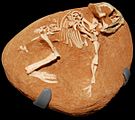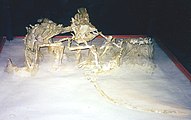Protoceratops
| Protoceratops | ||||||||||||
|---|---|---|---|---|---|---|---|---|---|---|---|---|

Skeleton of Protoceratops andrewsi |
||||||||||||
| Temporal occurrence | ||||||||||||
| Upper Cretaceous (late Santonium to Middle Campanium ) | ||||||||||||
| 85.2 to 76.4 million years | ||||||||||||
| Locations | ||||||||||||
| Systematics | ||||||||||||
|
||||||||||||
| Scientific name | ||||||||||||
| Protoceratops | ||||||||||||
| Granger & Gregory , 1923 | ||||||||||||
| species | ||||||||||||
|
||||||||||||
Protoceratops is a genus of pelvic dinosaurs (Ornithischia) from the Ceratopsia group , within which it is the namesake and best-known representative of the Protoceratopsidae . A distinction is made between two species, P. andrewsi and P. hellenikorhinus, described in 2001.
features
Protoceratops was a dinosaur that was around 1.8 to 2 meters long and around 0.75 meters high at the shoulder. He moved quadruped (four-legged).
The skull was large compared to the rest of the body, narrow at the muzzle and broad in the cheek region. As with all ceratopsians, the snout was formed by the rostral bone and the predentale . P. andrewsi had the incisive bone small, pin-shaped teeth at P. hellenikorhinus missing. The teeth located on the maxillary and dental were leaf-shaped. The nasal bone had a small, bony comb. This ridge was only a convergent development to the nasal horn of the Ceratopsidae . As with all more highly developed ceratopsians, the neck shield consisting of the parietal and scale bone was conspicuous . The shape and size of the neck shield varies considerably with different finds. More detailed studies show that the neck shield grows very rapidly when sexual maturity is reached, which suggests that it was important for the choice of partner and that it developed in the course of sexual selection .
The front legs were short, the broad front feet ended in five toes. The hind feet were longer and had four toes with blunt hooves.
Paleobiology
Finds of Protoceratops are known in all stages of development, from the hatchling to the adult. Egg finds that were previously attributed to this dinosaur are now considered to be the eggs of an Oviraptorosaur . 15 hatchlings were found in one nest, around 25 centimeters long and initially with a very small neck shield. This grew with age, and a gender dimorphism can also be seen. Some animals, possibly the males, had a significantly larger neck shield and a more pronounced nasal crest than the others, presumably the females. Several skeletons found together suggest that these animals lived in groups; the more pronounced skull features of the males may be signs of sexual selection . The nasal crests could also have been used in battles for mating privilege.
The pointed snout enabled selective feeding, Protoceratops , like all Ceratopsier, was a herbivore.
An extraordinary find from 1971 shows a Protoceratops and a Velociraptor , a theropod predatory dinosaur, who perished in battle. Both animals died in the process; they were probably buried in sand, for example in a sandstorm. The find allows conclusions to be drawn about the predators of Protoceratops .
Fossil discovery of a Protoceratops and a Velociraptor in battle
Discovery and naming
The first fossil finds of Protoceratops were discovered in the 1920s during the Mongolia expedition by Roy Chapman Andrews in the Gobi desert ( Ömnö-Gobi-Aimag ) and first described in 1923 . The name, derived from the Greek words protos ("first") and keratops (= "horny face"), reveals its meaning as the presumed ancestor of the already known ceratopsians. The type species is P. andrewsi . Other finds come from China in the provinces of Gansu and Inner Mongolia , here the remains of the second species, P. hellenikorhinus , described in 2001 , were found. The finds are dated in the Upper Cretaceous (late Santonium to Middle Campanium ) to an age of around 85 to 76 million years.
Systematics
Protoceratops is the namesake of the Protoceratopsidae family within the Ceratopsia . This family has an eventful taxonomic past and previously served as a collection group for all Ceratopsia that were not counted among the Ceratopsidae . Today this family is limited to a few Asian genera.
literature
- You Hailu, Peter Dodson : Basal Ceratopsia. In: David B. Weishampel , Peter Dodson, Halszka Osmólska (eds.): The Dinosauria . 2nd edition. University of California Press, Berkeley CA et al. 2004, ISBN 0-520-24209-2 , pp. 478-493, digitized version (PDF; 807.25 kB) .
- David E. Fastovsky , David B. Weishampel: The Evolution and Extinction of the Dinosaurs. 2nd edition. Cambridge University Press, Cambridge et al. 2005, ISBN 0-521-81172-4 .
Individual evidence
- ^ Gregory S. Paul : The Princeton Field Guide To Dinosaurs. Princeton University Press, Princeton NJ et al. 2010, ISBN 978-0-691-13720-9 , pp. 254-256, online .
- ^ David WE Hone, Dylan Wood, and Robert J. Knell. Positive allometry for exaggerated structures in the ceratopsian dinosaur Protoceratops andrewsi supports socio-sexual signaling. Palaeontologia Electronica, 2016





